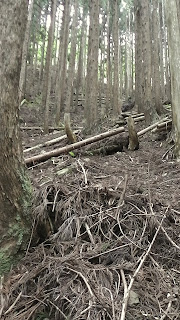 . . . . or, more appropriately - "The Best Laid Plans of Mice and Men" e.t.c. Yep, I thought I did all my homework when planning for this trip - check the map & course, the weather, food & drink ++++ but, one wrong turn, and I ended-up back about where I commenced my hike, adding an hour or more and a couple of extra kilometers to my outing.
. . . . or, more appropriately - "The Best Laid Plans of Mice and Men" e.t.c. Yep, I thought I did all my homework when planning for this trip - check the map & course, the weather, food & drink ++++ but, one wrong turn, and I ended-up back about where I commenced my hike, adding an hour or more and a couple of extra kilometers to my outing.I was returning to the mountain hamlet of Kumogahata, after several weeks respite, in what was to be my fifth trip into the area; the first two hiking in the Sajikigatake area, the second two on my mountain-bike into the area where I was heading today.
Japan is in the midst of the annual "Rainy Season" and, what makes it difficult, when planning any outdoor event, is the unpredictability of the weather; all week the forecast had been for cloudy weather but, come the morning of my hike, rain was predicted for later in the day. As I was all prepared and packed, I decided to go for it.
 |
| Map Location. |
Five minutes in and my first stop - Tokoku-ji Temple didn't rate very highly on my list of Buddhist Temples, actually, if it wasn't for the monument (pictured above and right) that I read about, I would most probably have walked straight passed it. In the rear of the cemetery, on top of a large rock, is a stone monument bearing a Haiku by the famous poet, Matsuo Basho.
"How I miss my Father and Mother - the cry of the Pheasant".
Back on the road again and my lane soon becomes an unsealed and muddy track - great off-road cycling territory. Earlier in the week there had been some precipitation and I needed to be aware of the rivers and streams, as-well-as landslides.
 |
| Map Location. |
Then, without realizing it, it was very-very quiet. The local bird life being the only sound discernible. And my panting. As I stopped to take-in the serenity, I discovered I had arrived at the junction to Mt Kibuneyama.
 |
| Map Location. |
 |
| Somewhere out there is Kyoto City. |
 |
| Tokaido Road. |
 The map said it was a 15-minute walk to the summit, which it was, but it was quite steep and, as my physical condition was deteriorating, this was the last thing I needed. Along the way I took note of the variety of growths on the trees. Mt Mukoyama (map location), 426m, did offer me a partial view of the northern suburbs of Kyoto. As I was in urgent need of a coffee intake, along with some sultana buns, I didn't stay long at the summit and made my way down into the settlement of Ninose. And it was a steep descent, with many hairpin bends to navigate.
The map said it was a 15-minute walk to the summit, which it was, but it was quite steep and, as my physical condition was deteriorating, this was the last thing I needed. Along the way I took note of the variety of growths on the trees. Mt Mukoyama (map location), 426m, did offer me a partial view of the northern suburbs of Kyoto. As I was in urgent need of a coffee intake, along with some sultana buns, I didn't stay long at the summit and made my way down into the settlement of Ninose. And it was a steep descent, with many hairpin bends to navigate.  |
| Map Location. |
From the shrine I strolled through the settlement of Ninose to the local railway station. The train I was about to take is part of the Eizan Line, which links Kyoto City with the village of Kurama, a popular tourist destination. Once back at Demachiyanagi, I boarded my train for home and, once safely ensconced in my comfortable seat, time for my hikers reward - One-Cup Sake. Kanpai.
Video - https://www.youtube.com/watch?v=6Fyz-nIaNKA
Course Details - http://www.cateyeatlas.com/trip/detail/682953/






































